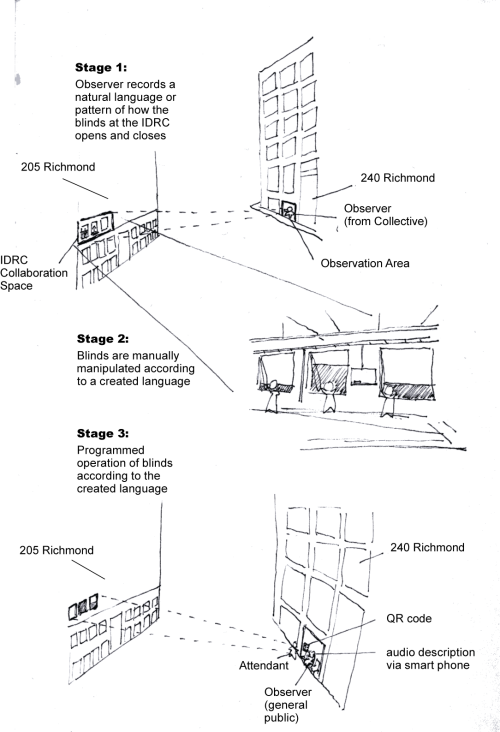Blind Reading: by 32 Pigeons
We are an art, performance and technology-making collective made up of design, theatre, and visual art professionals who landed together in the MDes in Inclusive Design this year at OCADU.
Locations
The three windows in the IDRC Collaboration Space on the second floor at 205 Richmond and a street level enclave across the street at 240 Richmond.
Description of Proposed Work
The three windows as visible from the outside will be treated as a three-pixel display capable of relaying three bits of information. Across the street in the enclave will be the observation area, like an urban duck blind, this will be a designated spot for watching, although observers may be found elsewhere.
Phase 1—Field Study Notes and code development
We will note the natural use of the blinds by observing from across the street, and by asking collaboration room (205 Richmond) users to note how the blinds are used. We will photograph the changes and play around with the blinds to create other changes. From these observations, we will attempt to find a way to encode Braille within the natural movements of the blinds. We know that in normal Braille, each Braille cell consists of six dots, which coincidentally can be logically divided into left and right halves (and by chance are conveniently numbered 1, 2, 3 and 4, 5, 6). So the three windows can be viewed as half a Braille cell, and so it is possible to break each Braille cell into two and then serialize them to communicate Braille using the three windows.
One possible serialization (to be done successively):
- Display the left half of the Braille cell
- Display the right half of the Braille cell
- Display three blank dots (corresponding to the inter-characterspacing of real brailed texts)
We can then take any text in Braille, serialize it, and then communicate the result using the three windows.
Phase 2—Manual Iteration
There will be 3 operators of the blinds at 205 Richmond and 1 set of observers across the street. In this phase we will introduce the rudimentary coding language of the blinds. No translation will be available but the set of observers may converse with others on “educated and non-educated” guesses.
Phase 3—Programmed (automated) Iteration
A program of coded language will send messages for 1 hour a day for seven days. A translator will be available in the duck blind and a QR code will link to a website to audio descriptions of the blind readings.
All phases will be recorded.
Artists Statement
As Master Students in Inclusive Design, we want to use art, performance and technology to reframe disability as a condition rather than a trait. With this and our other projects we will attempt to create the following:
The possibility of experiencing the mismatch between a user and their need and ability to participate in an experience.
The opportunity to think differently about the space in between knowing and not knowing.
A spontaneous interruption in what is perceived as normality in this case in a visually dominated world.
The chance to explore our expectations of language in spaces and to perhaps interrupt those expectations with curiosity followed by the frustration of not understanding and perhaps landing in the relief or discomfort of finding meaning.
A departure point for our work at OCADU, as students, will attempt to echo through and remain playful with the graphic representation of OCADU. In its logo OCAD is separate from U. Typographically what is between OCAD and U or OCAD and University is a space, a device of separation or exclusion. Does this space exclude U from being part of OCAD and OCAD from being part of U? While we acknowledge that sometimes exclusion cannot be designed away, can we as Master of Inclusive Design students strive to include to the greatest extent possible? The space we will try to investigate through our art, performance and technology work will be this small window between OCAD and U, a space, not here but not quite there yet and all the margins in between.
Contact
- Qi Chen
- Jan Derbyshire
- Ambrose Li
- Angela Punshon
